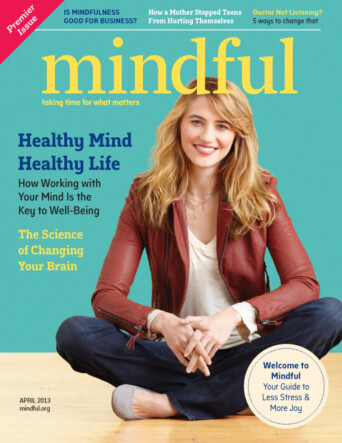Calmer Choice Featured in Mindful Magazine
Founder Fiona Jensen talks with Mindful magazine about the origins of Calmer Choice in their April 2013 issue, reprinted below.
A Lifeline for Teens
Stress, anxiety, drugs, murder, suicide—and teens. It’s the stuff of front-page news, viral YouTube videos, and TV dramas. Yet for Fiona Jensen in Cotuit, Massachusetts, on Cape Cod, it hit way too close to home.
Jensen certainly didn’t need to read the latest study about the impact of stress on teens: her daughter and her friends were a living, breathing testament to it. It was December 2008, and Jensen and her 16-year-old daughter had just returned from the funeral of a high-school friend who had been murdered during an alleged drug-related incident. Of the group seated in Jensen’s kitchen after the funeral, one of the teens was addicted to oxycodone, one was so anxious she vomited every morning before school, and another was on medication for depression. Describing her own daughter at the time, Jensen says she was “a time bomb of anger and sadness.”
“What’s going on with these teenagers? They’re constantly in crisis mode—reacting, not responding.”
Her observations dovetailed with statistics being reported around the same time in a 2009 national survey conducted by the American Psychological Association: 28% of teens and 14% of tweens said they “wor- ried a lot” or “a great deal”— and far more than their parents were aware of. The Centers for Disease Control and Preven- tion lists suicide as the third leading cause of death for youth between the ages of 10 and 24. That translates into approximately 4,600 young lives lost each year in the U.S.
Jensen was seeing more and more of it playing out in her community. Six months after that first funeral, there were two more: both teen suicides.

Something Has to Change
“At that moment, I thought, Okay that’s it—I have to do something,” says Jensen. “Having a mindfulness practice of my own, I felt that part of the issue is that these kids have absolutely no ability to pause.”
Jensen knew that any kind of solution had to be part of the school day, since a stress-reduction program held at the end of the day likely wouldn’t attract many teenagers. Without knowing anything about approaching school boards, creating educational programs, or fundraising—Jensen is an occupational therapist by trade—she forged ahead. By January 2010, she had organized the first pilot program to teach mindful breathing, meditation, and other stress-reduction techniques. Sixty-five students took part in this program. In June of that year, Calmer Choice received non-profit status. The following school year, the program reached 800 kids; the year after that, 1,500.
Jensen projects that by the end of the current school year the Calmer Choice program will have been delivered in more than 100 classrooms to more than 2,000 students. And it’s not just for teens—kids from kindergarten to twelfth grade, in five different school districts on Cape Cod, now have access to the program.
“We’ve had kids tell us they use mindfulness practices to fall asleep at night,” says Jensen. “They use them before a football game or a wrestling match. Instead of punching a hole in the wall when they’re frustrated, they sit down and practice their mindful breathing.”
Jensen says mindfulness is about teaching kids inner resilience—teaching them from the inside out. To do that, the program explores how stress affects the brain and how mindfulness can help anyone regain control—knowledge that prompts self-regulation.
Calmer Choice is collaborating with Tufts University’s Department of Occupational Therapy to measure the outcomes of the program. The results will be shared at the Center for Mindfulness annual scientific conference in April.
Calmer Choice has become a full-time job for Jensen (in addition to her other full-time job). But she has no intention of scaling back. “My vision,” Jensen says, “is that in school you learn math, you learn science, you learn history, you learn mindfulness.
“Imagine that by the time you graduate you have this thing called mindfulness in your toolbox. Then, when you get to college and you feel like jump- ing out of your dorm window—because you just broke up with your boyfriend and failed your German test and life is too overwhelming—you think, wait a minute, what was that thing I learned in school?”